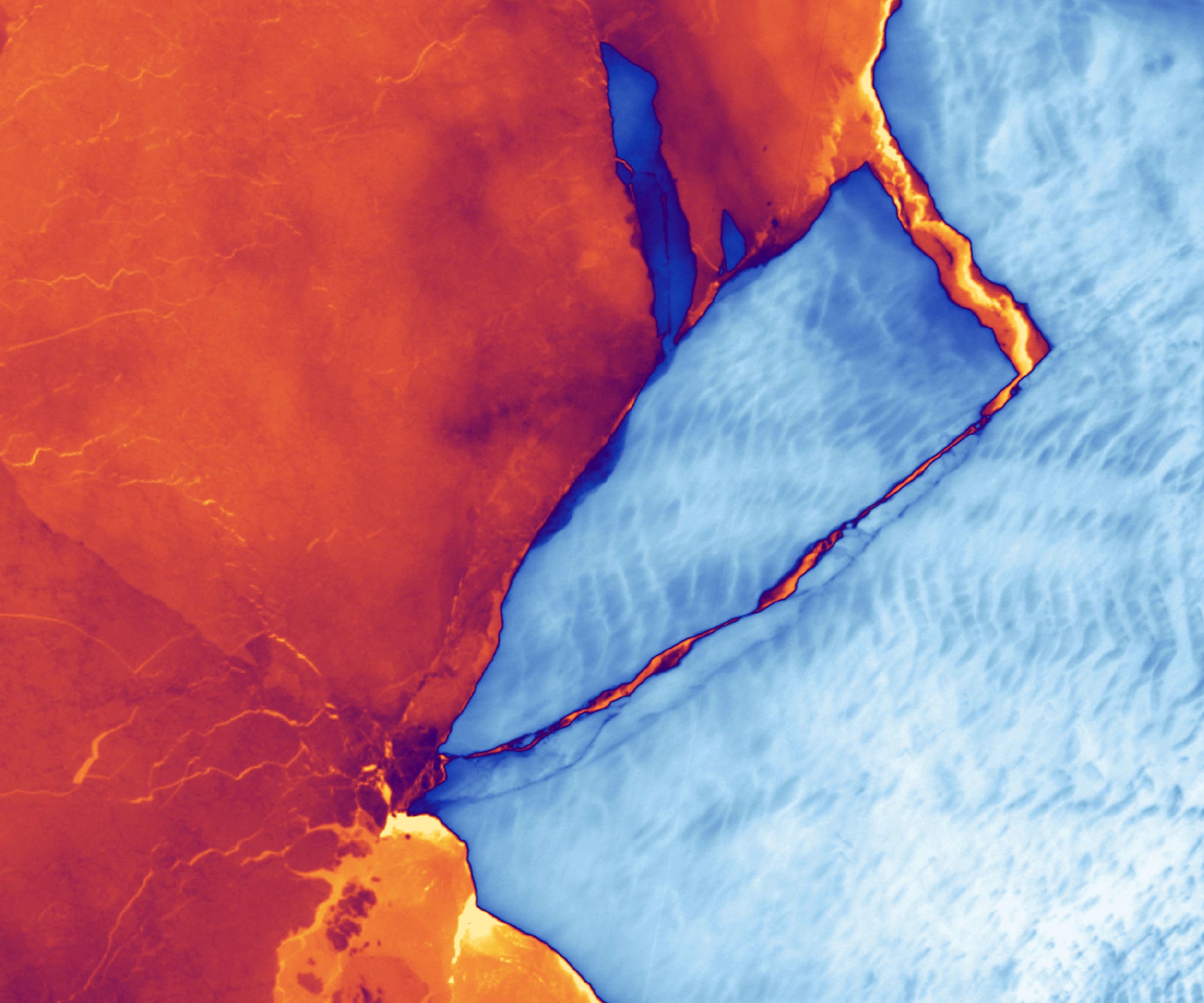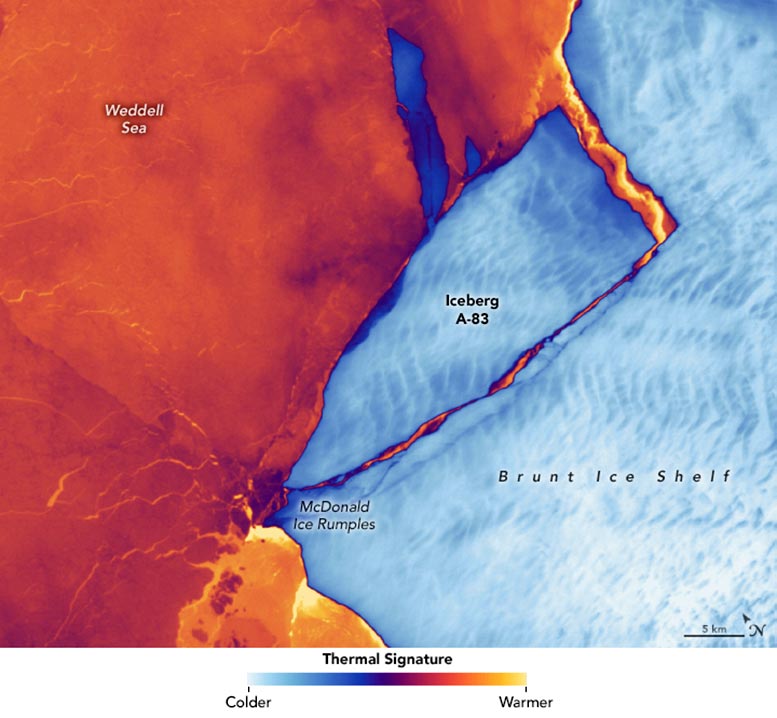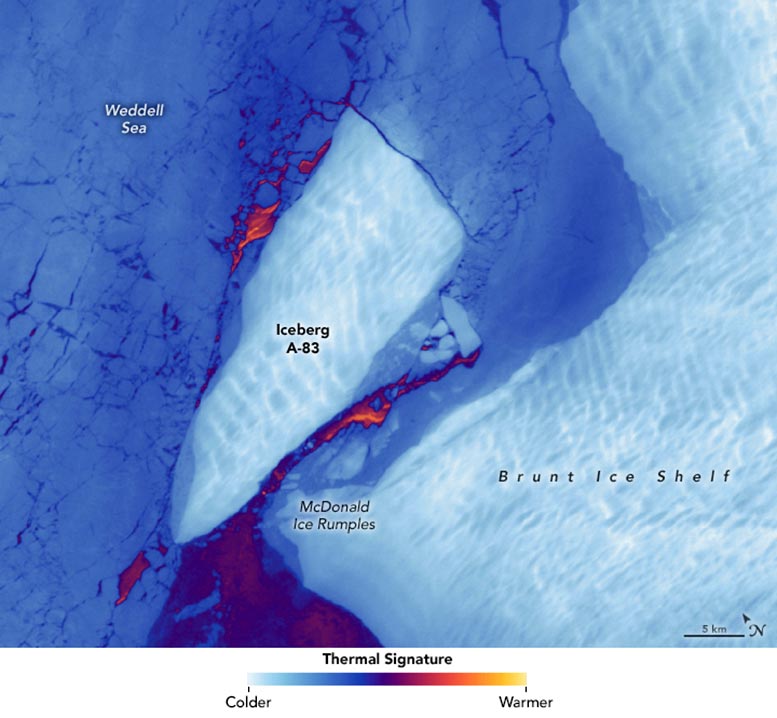


Under the cloak of darkness, Iceberg A-83 wiggled away from glue-like sea ice and drifted farther from the Brunt Ice Shelf—but not without sustaining some damage.
After detaching from the Brunt Ice Shelf in May 2024, Iceberg A-83 was trapped by dense sea ice until late winter allowed its movement. Satellite imagery from Landsat 9, tracking the iceberg’s thermal footprint, showed its journey and interactions with the environment, highlighting the breakup of parts in September due to underwater bedrock.
Breaking From the Brunt Ice Shelf
Since breaking from the Brunt Ice Shelf in May 2024, a large Antarctic iceberg spent the first few months of its existence mostly hemmed in by the surrounding glue-like sea ice, especially in the new rifts. But late in the Southern Hemisphere’s winter, when sea ice began to fracture and drift, Iceberg A-83 made some progress in its seaward journey away from the shelf.
Thermal Monitoring With Landsat 9
These false-color images show the iceberg on May 22, 2024 (left), shortly after the ice broke from the shelf, and on August 26, 2024 (right). Both images were acquired with the TIRS-2 (Thermal Infrared Sensor-2) on Landsat 9. They are part of a special expanded data collection program called LEAP (Landsat Extended Acquisitions of the Poles), which has been building year-round image records of glaciers, ice shelves, and sea ice around Antarctica, Greenland, and the Arctic Ocean since 2022.
Thermal images like these can help scientists keep watch over Earth’s polar areas, even when the Sun is below the horizon and visible images are unavailable. Winter in the region lasts from March through October, with 105 of these days engulfed in 24-hour darkness, according to the British Antarctic Survey (BAS). The BAS operates the Halley VI Research Station, which is located on the remainder of the Brunt Ice Shelf.
Seasonal Dynamics and Temperature Variations
Yellows and oranges indicate areas where surface temperatures are warmer, like open water or thin sea ice, while blues denote areas of colder temperatures, like the thicker ice of the iceberg and adjacent ice shelf. BAS has noted that winter air temperatures on the ice shelf are typically below minus 20 degrees Celsius (minus 4 degrees Fahrenheit), with extreme lows of around minus 55°C (minus 67°F).
Note the relatively cool surface temperature of the ice-covered Weddell Sea in August compared to May. Sea ice around Antarctica reaches its maximum annual extent and thickness in late winter, usually around mid- to late-September. But even the relatively thick, late-winter sea ice can succumb to a large iceberg, in this case about the size of Portland, Oregon. According to Christopher Shuman, a University of Maryland, Baltimore County, glaciologist based at NASA’s Goddard Space Flight Center, cracks in the sea ice were evident in late July. The berg “clearly had broken from the ‘glue’ (mélange) in early August,” he said.
The Journey of Iceberg A-83
By September, the European Space Agency’s Sentinel-1 mission and the NASA-NOAA Suomi NPP satellite observed that several pieces had broken off from Iceberg A-83 as it spun and tried to pass the McDonald Ice Rumples, a submerged knob of bedrock that has served as a pinning point for part of the shelf. However, none of the broken iceberg pieces were large enough to be named by the U.S. National Ice Center (USNIC). As of September 13, Iceberg A-83 was the 15th largest of the 46 Antarctic icebergs being tracked by the USNIC.
NASA Earth Observatory image by Lauren Dauphin, using Landsat data from the U.S. Geological Survey.